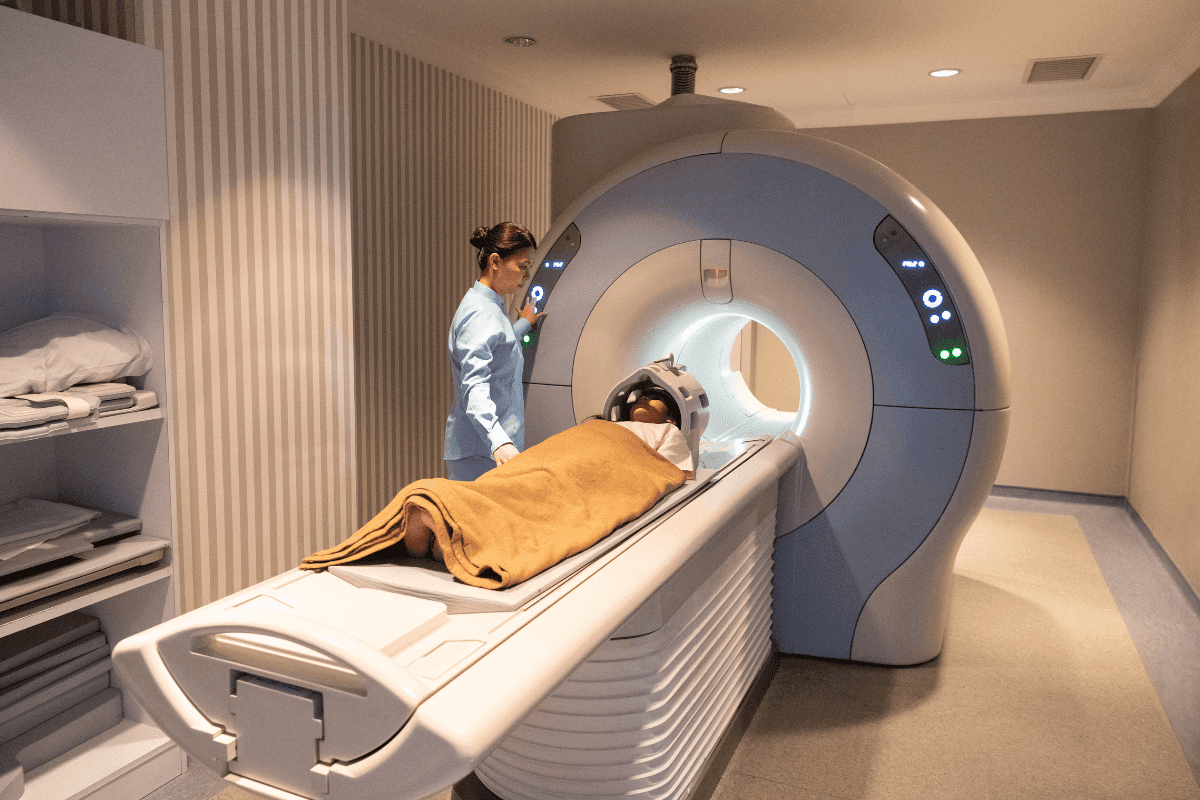Last Updated on November 26, 2025 by Bilal Hasdemir

When bile flow from the liver is blocked, it can cause serious symptoms. These can include jaundice, itching, and pain in the abdomen. At Liv Hospital, we use advanced stenting to fix this problem. This method is less invasive and helps restore bile flow.Learn reasons for a stent placed in liver and bile duct, with details on procedure and care.
A stent is a thin tube that keeps the bile duct open. This allows bile to move into the small intestine. Placing a stent can help ease symptoms like jaundice and pain.
According to trusted health sources, blockages can happen for many reasons. These include surgery, scar tissue, or tumors. Such blockages can cause bile to build up in the liver, leading to infection.
Key Takeaways
- A stent is used to relieve obstruction and restore bile flow from the liver to the intestines.
- Bile duct cancer or other conditions can cause blockages that lead to symptoms like jaundice and abdominal pain.
- Stenting procedures are a minimally invasive solution to alleviate symptoms and support further treatment.
- The placement of a stent can help prevent infection and other complications associated with bile duct blockages.
- Liv Hospital offers advanced stenting procedures with a focus on patient-centered care.
Understanding Liver and Bile Duct Anatomy

To understand the importance of liver and bile duct stents, we must first know the anatomy. The liver and bile ducts are key to our digestive system. They are vital for our health.
The Role of the Liver in Digestion
The liver is a vital organ that does many things. It makes bile, a fluid that helps digest fats. Bile breaks down fats into smaller pieces for our body to absorb.
We make about one liter of bile each day. It goes through the bile ducts to the gallbladder. When we eat, the gallbladder releases bile into the small intestine for fat digestion.
Bile Ducts and Their Function
The bile ducts are tubes that carry bile from the liver to the small intestine. They are essential for digestion, making sure bile gets to the intestine on time.
The bile ducts are divided into intrahepatic and extrahepatic ducts. Intrahepatic ducts are inside the liver, collecting bile. Extrahepatic ducts are outside the liver and merge to form the common bile duct, which empties into the small intestine.
Knowing the liver and bile duct anatomy is key for diagnosing and treating problems. The table below shows the liver and bile ducts’ roles in digestion.
| Organ/Structure | Function |
| Liver | Produces bile to aid in fat digestion |
| Bile Ducts | Transports bile from the liver to the small intestine |
| Gallbladder | Stores bile and releases it into the small intestine during digestion |
In conclusion, the liver and bile ducts are vital to our digestive system. Their anatomy and functions are why stents are needed in some medical conditions. We will look into this further in the next sections.
What Is a Stent Placed in the Liver and Why Is It Used?

Biliary stenting is a procedure that puts a small tube in the bile duct. This helps restore bile flow. It’s key for those with bile duct obstruction, which can cause serious health issues if not treated.
Definition and Purpose
A stent in the liver is a device to keep the bile duct open. It lets bile flow into the small intestine. The main goal is to relieve blockages and restore bile flow.
Bile duct stents, made of plastic or metal, treat many issues. These include strictures, tumors, and gallstones blocking the bile duct. By fixing these problems, stenting eases symptoms like jaundice, itching, and pain. This greatly improves a patient’s life quality.
History of Biliary Stenting
Biliary stenting started in the early 1980s as a treatment for blockages. Over time, stent design and materials have greatly improved. At first, plastic stents were used, but now self-expanding metal stents (SEMS) are more common. They last longer and have fewer blockage risks.
Today, biliary stenting is a top choice for many with bile duct blockages. It’s less invasive and very effective. The field keeps growing, with new materials and methods being explored to better help patients.
Types of Liver and Bile Duct Stents
There are different stents for liver and bile duct issues, each with its own benefits and drawbacks. The right stent depends on the condition, the patient’s health, and the treatment needs.
Plastic Stents
Plastic stents are among the first used for biliary drainage. They’re made from materials like polyethylene or Teflon, which don’t react with tissue. These stents are often used for temporary relief in cases like bile duct strictures or post-surgical leaks.
- Easier to remove or replace compared to metal stents
- Less expensive than metal stents
- Available in various sizes and configurations
But, plastic stents can clog more easily due to sludge or biofilm. This means they might need to be replaced more often.
Self-Expanding Metal Stents (SEMS)
SEMS expand to a set size after being deployed. They last longer than plastic stents. SEMS are great for malignant biliary obstructions, like those from pancreatic or cholangiocarcinoma cancer.
- Higher patency rates compared to plastic stents
- Less prone to occlusion
- Can be used in cases where plastic stents are not effective
Even with their benefits, SEMS are harder to remove and cost more than plastic stents.
Biodegradable Stents
Biodegradable stents are a newer option. They dissolve over time, possibly avoiding the need for removal or replacement. These stents are made from materials that gradually degrade in the body, like certain polymers or metals.
- Potential reduction in long-term complications associated with permanent stents
- May decrease the need for reintervention
- Offers a promising solution for benign biliary conditions
Biodegradable stents are promising, but their long-term safety and effectiveness are being studied.
Malignant Conditions Requiring a Stent Placed in Liver
Malignancies like pancreatic cancer and cholangiocarcinoma often block the bile ducts. This blockage can lead to jaundice, itching, and poor liver function. A stent is needed to fix this problem.
Pancreatic Cancer
Pancreatic cancer is a common cause of bile duct blockage. The tumor can press on or grow into the bile duct. Stent placement helps keep bile flowing, easing symptoms like jaundice and itching.
Recent studies show that endoscopic stenting is now the top choice. It’s less invasive and works well.
Cholangiocarcinoma (Bile Duct Cancer)
Cholangiocarcinoma, or bile duct cancer, also needs biliary stenting. This cancer grows in the bile ducts, causing blockage. Stenting helps manage symptoms and improves life quality for those with tumors that can’t be removed.
“The use of stents in managing cholangiocarcinoma has shown significant promise in improving patient outcomes by ensuring proper bile drainage.”
Liver Cancer
Liver cancer, when advanced, can block the bile ducts. Placing a stent in the liver can help manage symptoms. It improves bile flow, liver function, and patient comfort.
Other Malignancies Causing Biliary Obstruction
Other cancers, like metastatic disease in the liver or lymph nodes near the bile ducts, can also block the bile ducts. In these cases, stent placement is a good way to ease symptoms. It helps improve the patient’s quality of life.
In summary, many cancers need a stent in the liver to manage bile duct blockage. Knowing about these conditions and treatments is key to giving the best care to patients.
Benign Conditions Requiring Biliary Stents
Benign biliary conditions can really affect a person’s life. Biliary stenting is a helpful treatment. It helps bile flow normally and relieves symptoms.
Bile Duct Strictures
Bile duct strictures are narrowings in the bile ducts. They can happen for many reasons, like chronic pancreatitis or after gallbladder surgery. Biliary stenting is a good way to treat these, making the duct wider and improving bile flow.
Putting in a stent can greatly help by easing the blockage. Sometimes, more than one stent is needed to fully open the area.
Post-Surgical Bile Leaks
Post-surgical bile leaks can happen after biliary system surgeries. These leaks can cause a lot of problems if not fixed quickly. Biliary stenting is a quick fix, letting bile flow through the stent and bypassing the leak.
The stent helps the bile duct heal and lowers the chance of more problems. Doctors decide to use a stent based on how bad the leak is and where it is.
Severe Gallstone Disease
Severe gallstone disease can block the bile duct if a stone gets stuck. While removing the stone is usually the main treatment, biliary stenting might be used in some cases. This could be when the stone can’t be taken out right away or if there are many stones.
Stenting keeps bile flowing and can be a temporary fix until a better treatment is found.
Acute Cholangitis
Acute cholangitis is a bacterial infection of the bile duct, often caused by blockage. Quick treatment is key to avoiding serious issues. Biliary stenting, along with antibiotics, can be a good treatment. It helps restore bile flow and fight the infection.
In some cases, stenting is used as a temporary solution until a more lasting treatment, like stone removal or surgery, can be done.
Symptoms Indicating the Need for Biliary Stenting
Certain symptoms can show that you need biliary stenting to fix bile duct blockage. These signs come from bile and toxin buildup. This buildup causes different health problems.
Jaundice
Jaundice makes your skin and eyes turn yellow. It happens when bilirubin builds up in your blood. Jaundice is a key sign that your bile duct is blocked. Stenting can help get bile flowing again.
Pruritus (Itching)
Pruritus, or severe itching, is linked to bile duct blockage. The exact reason for itching isn’t known. But it’s thought to be from bile salts in the skin. Stenting can greatly reduce itching and improve life quality.
Abdominal Pain
Abdominal pain is common in those with bile duct blockage. Pain can be mild or very severe. It often hurts in the right upper abdomen. Biliary stenting can ease this pain by fixing the bile flow and reducing pressure.
Impaired Liver Function
Long-term bile duct blockage can harm the liver. Toxins can damage the liver and affect its work. Early stenting can stop liver damage and help liver function.
Diagnostic Procedures Before Stent Placement
Before placing a stent in the liver or bile duct, we do several tests. These tests help us figure out the best treatment. They also check the patient’s overall health.
Blood Tests
Blood tests are key to checking liver function. They help spot liver damage or problems. A top gastroenterologist says, “Blood tests are vital for understanding the liver’s health and guiding further tests.”
Imaging Studies
Imaging like ultrasound, CT scans, and MRI are vital. They show us the liver and bile ducts. Advanced imaging helps plan the stent placement.
Endoscopic Retrograde Cholangiopancreatography (ERCP)
ERCP combines endoscopy and fluoroscopy to check bile and pancreatic ducts. It lets us see the bile ducts and prepare for stent placement. A medical journal notes, “ERCP has changed how we manage biliary obstruction, allowing for diagnosis and treatment at once.”
These tests help us decide if a stent is needed. Then, we create a treatment plan that fits the patient’s needs.
Stent Placement Procedures
Stent placement is key to easing symptoms of biliary obstruction. A stent, a small, mesh-like tube, is placed in the bile duct. This restores bile flow. We’ll look at the different stent placement methods, their benefits, and when to use them.
Endoscopic Stent Placement
Endoscopic stent placement is a less invasive method. It uses Endoscopic Retrograde Cholangiopancreatography (ERCP) to see the bile ducts and place the stent. This method is chosen for its low risk and comfort for the patient.
The process starts with sedating the patient. Then, an endoscope is used to reach the bile duct. A stent is then placed to keep the duct open. It’s great for dealing with blockages from stones, tumors, or strictures.
Percutaneous Transhepatic Biliary Drainage (PTBD)
PTBD is used when endoscopic access isn’t possible. It involves going through the skin and liver to reach the bile ducts. PTBD is good for patients with certain challenges or high bile duct obstructions.
PTBD needs careful planning to avoid risks like bleeding or infection. Yet, it’s a valuable option for those who can’t have endoscopic stent placement.
Surgical Placement
Surgical placement of a biliary stent is needed in some cases. This involves a surgical incision to access the bile ducts. It’s more invasive but sometimes necessary.
This method has higher risks than endoscopic or percutaneous methods. Yet, it’s vital for complex cases or when combined with other surgeries.
The choice of stent placement depends on the patient’s condition and the obstruction type. Each method has its role in managing biliary obstruction. Knowing these options is key to the best care.
Factors Influencing Stent Selection
Choosing the right stent is key to a patient’s health. Many factors are considered to make the best choice. These include the patient’s life expectancy, the location and extent of the blockage, and the cost.
Patient Life Expectancy
The patient’s life expectancy is a big factor. For those with short lives, the goal is to ease symptoms and improve life quality. Plastic stents are often chosen for their low cost and easy placement.
But, for patients with longer lives, self-expanding metal stents (SEMS) are better. They last longer and have a lower chance of getting blocked.
A study in the PMC journal shows how important life expectancy is. It affects the patient’s quality of life and how often they need more treatments
Location and Extent of Obstruction
The blockage’s location and size also matter. The type of stent depends on the bile duct’s shape and the blockage’s nature. For complex or high obstructions, SEMS are better. They fit well and stay open longer.
Cost Considerations
Cost is a big factor too. The cost to the patient and the healthcare system differs with each stent type. Metal stents cost more at first but may save money in the long run. This is because they need to be replaced less often.
| Stent Type | Patient Life Expectancy | Cost Considerations | Patency Rates |
| Plastic Stents | Limited | Lower upfront cost | Shorter patency |
| Self-Expanding Metal Stents (SEMS) | Longer | Higher upfront cost, potentially lower long-term cost | Longer patency |
Healthcare providers use these factors to choose the best stent. This helps improve patient outcomes and quality of life.
Potential Complications of Biliary Stents
Biliary stents are lifesaving but can cause problems. These issues depend on the stent type, where it’s placed, and the patient’s health.
Stent Occlusion
Stent occlusion is a big problem. It’s often caused by sludge or tumors. Symptoms like jaundice and itching can come back. We treat it by using plastic stents for easy replacement and self-expanding metal stents for less blockage.
Migration
Stent migration is when the stent moves. This can block more or cause other issues. We pick the right stent size and type to avoid this.
Infection
Infection is a risk, often from bacteria on the stent. We use antibiotics to prevent it.
Perforation
Perforation is rare but serious. It can happen during or after the stent is placed. We use careful methods and imaging to avoid it.
| Complication | Causes | Management |
| Stent Occlusion | Sludge, tumor growth | Stent replacement, self-expanding metal stents |
| Migration | Inappropriate stent size/type | Selecting appropriate stent size/type |
| Infection | Bacterial colonization | Antibiotic prophylaxis |
| Perforation | Technical issues during placement | Careful technique, imaging guidance |
Quality of Life Improvements After Stenting
Biliary stents can greatly improve life for those with liver and bile duct issues. They help restore bile flow. This leads to fewer symptoms, better liver function, and more treatment choices.
Relief of Symptoms
Biliary stenting mainly helps by easing symptoms of blockage. Symptoms like jaundice, pruritus (itching), and abdominal pain lessen. This makes patients feel more comfortable and improves their overall health.
- Jaundice: Stenting clears blockages, reducing yellow skin and eyes.
- Pruritus: Itching relief makes patients more comfortable and less likely to scratch and damage skin.
- Abdominal Pain: Less pain means patients can do more daily activities.
Improved Liver Function
Stenting also improves liver function by restoring bile flow. When bile ducts are blocked, bile builds up in the liver. This can harm the liver. Stenting clears the blockage, allowing bile to flow into the intestine. This aids digestion and lowers liver damage risk.
Improved liver function is shown through blood tests. These tests check liver enzyme and bilirubin levels. Better liver function means better health and quality of life for patients.
Impact on Treatment Options
Biliary stenting also expands treatment options for patients. It removes blockages, making other treatments possible. This is because stenting improves health enough for more treatments.
- Chemotherapy: Patients with some cancers can start or continue treatment.
- Surgery: Stenting makes patients healthier, better for surgery.
- Palliative Care: For those with advanced disease, stenting improves quality of life by reducing symptoms.
In summary, biliary stenting greatly improves life for those with liver and bile duct issues. It relieves symptoms, boosts liver function, and opens up more treatment options. Stenting is a key part of patient care.
Conclusion
We’ve looked into stent placement in the liver and bile duct. It’s a key treatment for biliary obstruction. This method can greatly improve a patient’s life and health.
Biliary stenting is a simple procedure that helps with symptoms like jaundice and pain. It also boosts liver function. Knowing about different stents helps doctors choose the best treatment for each patient.
Using a bile duct stent can change patient care for the better. It works well for many conditions, including cancer and strictures. This shows how versatile and effective stent placement can be.
In summary, stent placement in the liver or bile duct is a vital treatment. It can make a big difference in patient care. Understanding its benefits and risks helps doctors give the best care possible.
FAQ
What is a stent placed in the liver, and why is it used?
A stent is a thin tube used to keep the bile duct open. This allows bile to flow into the small intestine. It helps relieve symptoms like jaundice, itching, and abdominal pain caused by blockages.
What are the different types of liver and bile duct stents?
There are several types of stents, including plastic, self-expanding metal stents (SEMS), and biodegradable ones. Each has its own benefits and drawbacks. The choice depends on the patient’s condition and how long they might live.
What are the malignant conditions that require a stent placed in the liver?
Malignant conditions needing a stent include pancreatic cancer, cholangiocarcinoma, and liver cancer. These cancers can block the bile duct, causing jaundice and itching.
What are the benign conditions that require biliary stents?
Benign conditions needing stents include bile duct strictures and post-surgical leaks. Also, severe gallstone disease and acute cholangitis can require stent placement to restore bile flow.
What are the symptoms that indicate the need for biliary stenting?
Symptoms needing biliary stenting include jaundice, itching, abdominal pain, and impaired liver function. These signs can be due to blockages or leaks, and stents can help alleviate them.
How is a stent placed in the bile duct?
A stent can be placed through endoscopy, percutaneous transhepatic biliary drainage (PTBD), or surgery. The method chosen depends on the patient’s condition and the type of stent.
What are the possible complications of biliary stents?
Complications of biliary stents include blockage, migration, infection, and perforation. These issues can be managed with proper care and follow-up.
How does stent placement improve quality of life?
Stent placement can greatly improve the quality of life. It relieves symptoms, improves liver function, and can change treatment options. By restoring bile flow, it significantly enhances patient outcomes and quality of life.
What is the role of the liver in digestion?
The liver produces bile, which aids in fat digestion in the small intestine. Understanding the liver and bile ducts is key to knowing why stents are used.
What diagnostic procedures are used before stent placement?
Before stent placement, blood tests, imaging studies, and endoscopic retrograde cholangiopancreatography (ERCP) are used. These help diagnose blockages and determine the best treatment.
What factors influence stent selection?
Factors influencing stent selection include life expectancy, the location and extent of the obstruction, and cost. These factors help choose the best stent for each patient.
References
- Wagh, M. S., & Draganov, P. V. (2013). Effectiveness and safety of endoscopic treatment of benign biliary strictures using fully covered self-expanding metal stents (SEMS). Gastroenterology Research and Practice, 2013, 256275. https://pmc.ncbi.nlm.nih.gov/articles/PMC3727195/






